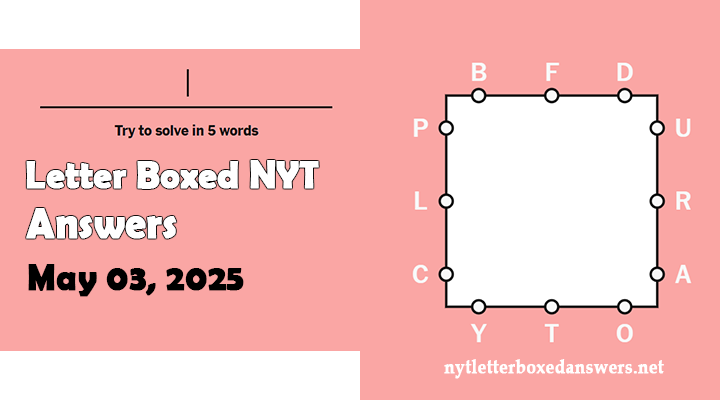NYT Letter Boxed quiz for Saturday May 3, 2025 is released. We came up with Letter Boxed May 3 2025 Answers and Hints for you. With the help of these hints, you will be able to guess the words of letter boxed quiz without revealing the answers and get the solution.
| Top | Right | Bottom | Left |
|---|---|---|---|
| BFD | URA | YTO | PLC |
| Two Words Solution | ||
|---|---|---|
| FLAB | BYPRODUCT | |
| BYPRODUCT | TACTFUL | |
| Three Words Solution | ||
|---|---|---|
| ADOLF | FLAB | BYPRODUCT |

Word 01:
This word has 4 letters, starts with F, and ends with B.
Informal term for soft, loose body fat.
Often associated with excess weight or lack of muscle tone.
Commonly used in fitness and health discussions.
Can be paired with words like “belly” or “burn.”
Short and slangy; rarely used in formal contexts.
May appear in workout motivation slogans.
The opposite of “firm” or “toned” body areas.
Sometimes used metaphorically to describe redundancy (e.g., “cut the flab”).
Likely to be found in diet or gym-related media.
Word 02:
This word has 9 letters, starts with B, and ends with T.
A secondary result or outcome, often unintended.
Common in manufacturing, chemistry, or economic processes.
Can be physical (like waste) or conceptual (like consequences).
Often considered less valuable than the main product.
Frequently used when discussing environmental impact.
Includes both beneficial and harmful side effects.
Compound word formed from “by” and “product.”
Can relate to side effects in chemical reactions.
May be used metaphorically in social science (e.g., “a byproduct of privilege”).
Word 01:
This word has 9 letters, starts with B, and ends with T.
A secondary result or outcome, often unintended.
Common in manufacturing, chemistry, or economic processes.
Can be physical (like waste) or conceptual (like consequences).
Often considered less valuable than the main product.
Frequently used when discussing environmental impact.
Includes both beneficial and harmful side effects.
Compound word formed from “by” and “product.”
Can relate to side effects in chemical reactions.
May be used metaphorically in social science (e.g., “a byproduct of privilege”).
Word 02:
This word has 7 letters, starts with T, and ends with L.
Describes someone skilled at handling sensitive situations politely.
Opposite of blunt or insensitive.
A valuable trait in leadership and diplomacy.
Rooted in the word “tact,” meaning a keen sense of what to say.
Often used to describe diplomatic people or statements.
Implies emotional intelligence and good judgment.
Helpful in resolving conflicts peacefully.
Can be used as a compliment for polite feedback.
Found in social and professional contexts alike.
Word 01:
This word has 5 letters, starts with A, and ends with F.
A Germanic male first name, historically common in Europe.
Famously associated with a controversial 20th-century political figure.
Derived from Old High German Adalwolf, meaning “noble wolf.”
Usage has significantly declined due to historical associations.
Sometimes used in historical documentaries or literature.
Related names include Adolfo and Adolphus.
May be referenced in studies of WWII or Nazi Germany.
Strong cultural and political connotation in the modern era.
Rarely given as a name post-1945.
Word 02:
This word has 4 letters, starts with F, and ends with B.
Informal term for soft, loose body fat.
Often associated with excess weight or lack of muscle tone.
Commonly used in fitness and health discussions.
Can be paired with words like “belly” or “burn.”
Short and slangy; rarely used in formal contexts.
May appear in workout motivation slogans.
The opposite of “firm” or “toned” body areas.
Sometimes used metaphorically to describe redundancy (e.g., “cut the flab”).
Likely to be found in diet or gym-related media.
Word 03:
This word has 9 letters, starts with B, and ends with T.
A secondary result or outcome, often unintended.
Common in manufacturing, chemistry, or economic processes.
Can be physical (like waste) or conceptual (like consequences).
Often considered less valuable than the main product.
Frequently used when discussing environmental impact.
Includes both beneficial and harmful side effects.
Compound word formed from “by” and “product.”
Can relate to side effects in chemical reactions.
May be used metaphorically in social science (e.g., “a byproduct of privilege”).

Chris Brown is a passionate word game love and problem solving expert. With over 15 years of experience in solving puzzle challenges, he provides daily NYT Letter Boxed answers, tips and strategies to help other players so that they can improve their solving skills. Whether you are stuck on a tricky puzzle or looking for new techniques, Chris is here to guide you with his expert solutions.